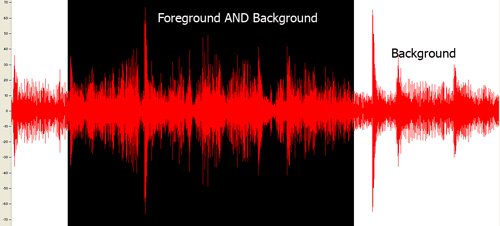See Understanding Techniques for WCAG Success Criteria for important information about the usage of these informative techniques and how they relate to the normative WCAG 2.0 success criteria. The Applicability section explains the scope of the technique, and the presence of techniques for a specific technology does not imply that the technology can be used in all situations to create content that meets WCAG 2.0.
Any technology
This technique relates to:
The objective of this technique is to allow authors to include sound behind speech without making it too hard for people with hearing problems to understand the speech. Making sure that the foreground speech is 20 db louder than the backgound sound makes the speech 4 times louder than the background audio. For information on Decibels (dB), refer to About Decibels.
A narrator is describing a riot scene. The volume of the riot scene is adjusted so that it is 20 db lower than the announcer's volume before the scene is mixed with the narrator.
This example demonstrates a voice with music in the background in which the voice is the appropriate 20 DB above the background. The voice (foreground) is recorded at -17.52 decibels (average RMS) and the music (background) is at -37.52 decibels, which makes the foreground 20 decibels louder than the background.
Audio Example: Foreground is 20 decibels above the background (mp3)
Transcript of audio example (good contrast):
"Usually the foreground refers to a voice that is speaking and should be understood. My speaking voice right now is 20 decibels above the background which is the music. This is an example of how it should be done.."
The audio example above is visually represented below in a snapshot of the file in an audio editor. A section is highlighted that contains foreground and background. It is a much larger wave than the section that contains only background.

This example demonstrates a voice with music in the background in which the voice is not 20 DB above the background. The voice (foreground) is at -18 decibels and the music (background) is at about -16 decibels making the foreground only 2 decibels louder than the background.
Audio Example: Foreground is less than 20 decibels above the background (mp3)
Transcript of audio example (bad contrast):
"This is an example of a voice that is not loud enough against the background. The voice which is the foreground is only about 2 decibels above the background. Therefore is difficult to understand for a person who is hard of hearing. It is hard to discern one word from the next. This is an example of what not to do."
The highlighted section contains foreground and background. The wave is almost the same size the section that contains only background, which means the background is too loud in comparison to the foreground voice.

Resources are for information purposes only, no endorsement implied.
About Decibels by Gregg Vanderheiden
Locate loud values of background content between foreground speech
Measure the volume in dB(A) SPL
Measure the volume of the foreground speech in dB(A) SPL
Subtract the values
Check that the result is 20 or greater.
#5 is true
If this is a sufficient technique for a success criterion, failing this test procedure does not necessarily mean that the success criterion has not been satisfied in some other way, only that this technique has not been successfully implemented and can not be used to claim conformance.